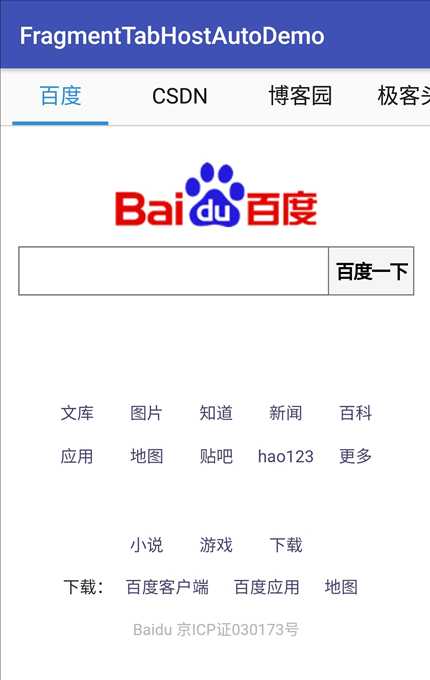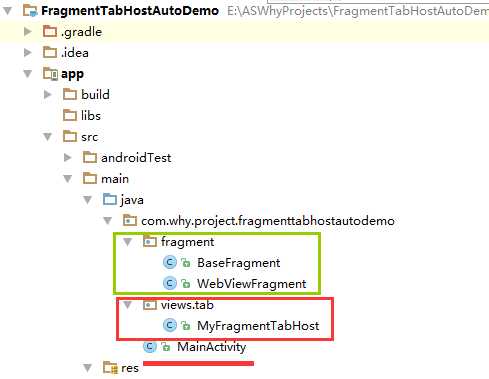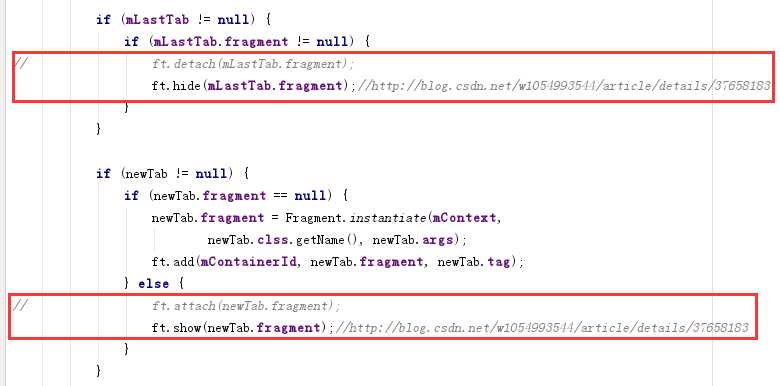标签:https map default utf-8 data 打开 idm viewpager play
版权声明:本文为博主原创文章,未经博主允许不得转载。
使用FragmentTabHost实现顶部选项卡(可滑动的效果)展现。

1、该Demo中采用的是FragmentTabHost的布局方案之一【命名为常规布局写法】;
2、使用自定义的FragmentTabHost;
3、实现可滑动效果;
4、设置下划线的宽度和文字的宽度一致;


注意事项:
1、 导入类文件后需要change包名以及重新import R文件路径
2、 Values目录下的文件(strings.xml、dimens.xml、colors.xml等),如果项目中存在,则复制里面的内容,不要整个覆盖

package com.why.project.fragmenttabhostautodemo.views.tab; import android.content.Context; import android.content.res.TypedArray; import android.os.Bundle; import android.os.Parcel; import android.os.Parcelable; import android.support.annotation.NonNull; import android.support.annotation.Nullable; import android.support.v4.app.Fragment; import android.support.v4.app.FragmentManager; import android.support.v4.app.FragmentTransaction; import android.util.AttributeSet; import android.view.View; import android.view.ViewGroup; import android.widget.FrameLayout; import android.widget.LinearLayout; import android.widget.TabHost; import android.widget.TabWidget; import java.util.ArrayList; /** * Created by HaiyuKing * Used 仿照FragmentTabHost并更改doTabChanged方法实现切换Fragment的时候不刷新fragment */ public class MyFragmentTabHost extends TabHost implements TabHost.OnTabChangeListener { private final ArrayList<MyFragmentTabHost.TabInfo> mTabs = new ArrayList<>(); private FrameLayout mRealTabContent; private Context mContext; private FragmentManager mFragmentManager; private int mContainerId; private OnTabChangeListener mOnTabChangeListener; private MyFragmentTabHost.TabInfo mLastTab; private boolean mAttached; static final class TabInfo { final @NonNull String tag; final @NonNull Class<?> clss; final @Nullable Bundle args; Fragment fragment; TabInfo(@NonNull String _tag, @NonNull Class<?> _class, @Nullable Bundle _args) { tag = _tag; clss = _class; args = _args; } } static class DummyTabFactory implements TabContentFactory { private final Context mContext; public DummyTabFactory(Context context) { mContext = context; } @Override public View createTabContent(String tag) { View v = new View(mContext); v.setMinimumWidth(0); v.setMinimumHeight(0); return v; } } static class SavedState extends BaseSavedState { String curTab; SavedState(Parcelable superState) { super(superState); } SavedState(Parcel in) { super(in); curTab = in.readString(); } @Override public void writeToParcel(Parcel out, int flags) { super.writeToParcel(out, flags); out.writeString(curTab); } @Override public String toString() { return "MyFragmentTabHost.SavedState{" + Integer.toHexString(System.identityHashCode(this)) + " curTab=" + curTab + "}"; } public static final Creator<MyFragmentTabHost.SavedState> CREATOR = new Creator<MyFragmentTabHost.SavedState>() { @Override public MyFragmentTabHost.SavedState createFromParcel(Parcel in) { return new MyFragmentTabHost.SavedState(in); } @Override public MyFragmentTabHost.SavedState[] newArray(int size) { return new MyFragmentTabHost.SavedState[size]; } }; } public MyFragmentTabHost(Context context) { // Note that we call through to the version that takes an AttributeSet, // because the simple Context construct can result in a broken object! super(context, null); initFragmentTabHost(context, null); } public MyFragmentTabHost(Context context, AttributeSet attrs) { super(context, attrs); initFragmentTabHost(context, attrs); } private void initFragmentTabHost(Context context, AttributeSet attrs) { final TypedArray a = context.obtainStyledAttributes(attrs, new int[]{android.R.attr.inflatedId}, 0, 0); mContainerId = a.getResourceId(0, 0); a.recycle(); super.setOnTabChangedListener(this); } private void ensureHierarchy(Context context) { // If owner hasn‘t made its own view hierarchy, then as a convenience // we will construct a standard one here. if (findViewById(android.R.id.tabs) == null) { LinearLayout ll = new LinearLayout(context); ll.setOrientation(LinearLayout.VERTICAL); addView(ll, new LayoutParams( ViewGroup.LayoutParams.MATCH_PARENT, ViewGroup.LayoutParams.MATCH_PARENT)); TabWidget tw = new TabWidget(context); tw.setId(android.R.id.tabs); tw.setOrientation(TabWidget.HORIZONTAL); ll.addView(tw, new LinearLayout.LayoutParams( ViewGroup.LayoutParams.MATCH_PARENT, ViewGroup.LayoutParams.WRAP_CONTENT, 0)); FrameLayout fl = new FrameLayout(context); fl.setId(android.R.id.tabcontent); ll.addView(fl, new LinearLayout.LayoutParams(0, 0, 0)); mRealTabContent = fl = new FrameLayout(context); mRealTabContent.setId(mContainerId); ll.addView(fl, new LinearLayout.LayoutParams( LinearLayout.LayoutParams.MATCH_PARENT, 0, 1)); } } /** * @deprecated Don‘t call the original TabHost setup, you must instead * call {@link #setup(Context, FragmentManager)} or * {@link #setup(Context, FragmentManager, int)}. */ @Override @Deprecated public void setup() { throw new IllegalStateException( "Must call setup() that takes a Context and FragmentManager"); } public void setup(Context context, FragmentManager manager) { ensureHierarchy(context); // Ensure views required by super.setup() super.setup(); mContext = context; mFragmentManager = manager; ensureContent(); } public void setup(Context context, FragmentManager manager, int containerId) { ensureHierarchy(context); // Ensure views required by super.setup() super.setup(); mContext = context; mFragmentManager = manager; mContainerId = containerId; ensureContent(); mRealTabContent.setId(containerId); // We must have an ID to be able to save/restore our state. If // the owner hasn‘t set one at this point, we will set it ourselves. if (getId() == View.NO_ID) { setId(android.R.id.tabhost); } } private void ensureContent() { if (mRealTabContent == null) { mRealTabContent = (FrameLayout) findViewById(mContainerId); if (mRealTabContent == null) { throw new IllegalStateException( "No tab content FrameLayout found for id " + mContainerId); } } } @Override public void setOnTabChangedListener(OnTabChangeListener l) { mOnTabChangeListener = l; } public void addTab(@NonNull TabSpec tabSpec, @NonNull Class<?> clss, @Nullable Bundle args) { tabSpec.setContent(new MyFragmentTabHost.DummyTabFactory(mContext)); final String tag = tabSpec.getTag(); final MyFragmentTabHost.TabInfo info = new MyFragmentTabHost.TabInfo(tag, clss, args); if (mAttached) { // If we are already attached to the window, then check to make // sure this tab‘s fragment is inactive if it exists. This shouldn‘t // normally happen. info.fragment = mFragmentManager.findFragmentByTag(tag); if (info.fragment != null && !info.fragment.isDetached()) { final FragmentTransaction ft = mFragmentManager.beginTransaction(); ft.detach(info.fragment); ft.commit(); } } mTabs.add(info); addTab(tabSpec); } @Override protected void onAttachedToWindow() { super.onAttachedToWindow(); final String currentTag = getCurrentTabTag(); // Go through all tabs and make sure their fragments match // the correct state. FragmentTransaction ft = null; for (int i = 0, count = mTabs.size(); i < count; i++) { final MyFragmentTabHost.TabInfo tab = mTabs.get(i); tab.fragment = mFragmentManager.findFragmentByTag(tab.tag); if (tab.fragment != null && !tab.fragment.isDetached()) { if (tab.tag.equals(currentTag)) { // The fragment for this tab is already there and // active, and it is what we really want to have // as the current tab. Nothing to do. mLastTab = tab; } else { // This fragment was restored in the active state, // but is not the current tab. Deactivate it. if (ft == null) { ft = mFragmentManager.beginTransaction(); } ft.detach(tab.fragment); } } } // We are now ready to go. Make sure we are switched to the // correct tab. mAttached = true; ft = doTabChanged(currentTag, ft); if (ft != null) { ft.commit(); mFragmentManager.executePendingTransactions(); } } @Override protected void onDetachedFromWindow() { super.onDetachedFromWindow(); mAttached = false; } @Override protected Parcelable onSaveInstanceState() { Parcelable superState = super.onSaveInstanceState(); MyFragmentTabHost.SavedState ss = new MyFragmentTabHost.SavedState(superState); ss.curTab = getCurrentTabTag(); return ss; } @Override protected void onRestoreInstanceState(Parcelable state) { if (!(state instanceof MyFragmentTabHost.SavedState)) { super.onRestoreInstanceState(state); return; } MyFragmentTabHost.SavedState ss = (MyFragmentTabHost.SavedState) state; super.onRestoreInstanceState(ss.getSuperState()); setCurrentTabByTag(ss.curTab); } @Override public void onTabChanged(String tabId) { if (mAttached) { final FragmentTransaction ft = doTabChanged(tabId, null); if (ft != null) { ft.commit(); } } if (mOnTabChangeListener != null) { mOnTabChangeListener.onTabChanged(tabId); } } @Nullable private FragmentTransaction doTabChanged(@Nullable String tag, @Nullable FragmentTransaction ft) { final MyFragmentTabHost.TabInfo newTab = getTabInfoForTag(tag); if (mLastTab != newTab) { if (ft == null) { ft = mFragmentManager.beginTransaction(); } if (mLastTab != null) { if (mLastTab.fragment != null) { // ft.detach(mLastTab.fragment); ft.hide(mLastTab.fragment);//http://blog.csdn.net/w1054993544/article/details/37658183 } } if (newTab != null) { if (newTab.fragment == null) { newTab.fragment = Fragment.instantiate(mContext, newTab.clss.getName(), newTab.args); ft.add(mContainerId, newTab.fragment, newTab.tag); } else { // ft.attach(newTab.fragment); ft.show(newTab.fragment);//http://blog.csdn.net/w1054993544/article/details/37658183 } } mLastTab = newTab; } return ft; } @Nullable private MyFragmentTabHost.TabInfo getTabInfoForTag(String tabId) { for (int i = 0, count = mTabs.size(); i < count; i++) { final MyFragmentTabHost.TabInfo tab = mTabs.get(i); if (tab.tag.equals(tabId)) { return tab; } } return null; } }
代码是复制的系统的FragmentTabHost,只有一小部分和系统不一样的代码:


<?xml version="1.0" encoding="utf-8"?> <!-- 带有下划线的顶部选项卡子项的布局文件(选择图片界面) --> <RelativeLayout xmlns:android="http://schemas.android.com/apk/res/android" android:id="@+id/toptabLayout" android:layout_width="wrap_content" android:layout_height="wrap_content" android:gravity="center" android:paddingTop="@dimen/tab_top_auto_padding" android:paddingLeft="@dimen/tab_top_auto_padding" android:paddingRight="@dimen/tab_top_auto_padding" > <!-- 标题 --> <TextView android:id="@+id/top_title" android:layout_width="wrap_content" android:layout_height="wrap_content" android:gravity="center" android:text="" android:textSize="@dimen/tab_top_auto_title_size" android:textColor="@color/tab_text_normal_top" android:layout_alignParentTop="true" android:layout_centerHorizontal="true" /> <!-- 下划线--> <!-- android:background="@color/tab_underline_selected_top" --> <TextView android:id="@+id/top_underline" android:layout_width="match_parent" android:layout_height="@dimen/tab_top_auto_height" android:background="@color/tab_auto_normal_top" android:layout_below="@id/top_title" android:layout_centerHorizontal="true" android:layout_marginTop="@dimen/tab_top_auto_padding" /> </RelativeLayout>
<?xml version="1.0" encoding="utf-8"?> <resources> <color name="colorPrimary">#3F51B5</color> <color name="colorPrimaryDark">#303F9F</color> <color name="colorAccent">#FF4081</color> <!-- *********************************顶部选项卡区域********************************* --> <!-- 顶部选项卡下划线背景色 --> <color name="tab_auto_normal_top">#00ffffff</color> <color name="tab_auto_selected_top">#3090d9</color> <!-- 顶部选项卡文本颜色 --> <color name="tab_text_normal_top">#191919</color> <color name="tab_text_selected_top">#3090d9</color> </resources>
<resources> <!-- Default screen margins, per the Android Design guidelines. --> <dimen name="activity_horizontal_margin">16dp</dimen> <dimen name="activity_vertical_margin">16dp</dimen> <!-- *********************************顶部选项卡区域********************************* --> <!-- 选项卡的内边距 --> <dimen name="tab_top_auto_padding">10dp</dimen> <!-- 选项卡标题的文字大小 --> <dimen name="tab_top_auto_title_size">18sp</dimen> <!-- 选项卡标题的下划线高度 --> <dimen name="tab_top_auto_height">3dp</dimen> </resources>
至此,选项卡子项的布局所需的文件已集成到项目中了。
<?xml version="1.0" encoding="utf-8"?> <manifest xmlns:android="http://schemas.android.com/apk/res/android" package="com.why.project.fragmenttabhostautodemo"> <!-- ======================授权访问网络(HttpUtil)========================== --> <!-- 允许程序打开网络套接字 --> <uses-permission android:name="android.permission.INTERNET"/> <application android:allowBackup="true" android:icon="@mipmap/ic_launcher" android:label="@string/app_name" android:supportsRtl="true" android:theme="@style/AppTheme"> <activity android:name=".MainActivity"> <intent-filter> <action android:name="android.intent.action.MAIN"/> <category android:name="android.intent.category.LAUNCHER"/> </intent-filter> </activity> </application> </manifest>
<?xml version="1.0" encoding="utf-8"?> <!-- 顶部选项卡区域 --> <com.why.project.fragmenttabhostautodemo.views.tab.MyFragmentTabHost xmlns:android="http://schemas.android.com/apk/res/android" android:id="@+id/tab_top_auto_ftabhost_layout" android:layout_width="match_parent" android:layout_height="match_parent" > <!-- 必须要有LinearLayout,因为FragmentTabHost属于FrameLayout帧布局 --> <LinearLayout android:layout_width="match_parent" android:layout_height="match_parent" android:orientation="vertical"> <!-- 选项卡区域 --> <!--注意:原来的配置:android:layout_height="?attr/actionBarSize"--> <TabWidget android:id="@android:id/tabs" android:layout_width="wrap_content" android:layout_height="wrap_content" android:layout_gravity="top|center_horizontal"/> <!-- 分割线 --> <View android:layout_width="match_parent" android:layout_height="1dp" android:background="#cfcfcf"> </View> <!-- 碎片切换区域,且其id必须为@android:id/tabcontent --> <FrameLayout android:id="@android:id/tabcontent" android:layout_width="match_parent" android:layout_height="0dp" android:layout_weight="1" /> </LinearLayout> </com.why.project.fragmenttabhostautodemo.views.tab.MyFragmentTabHost>


fragment_web.xml文件布局如下
<?xml version="1.0" encoding="utf-8"?> <LinearLayout xmlns:android="http://schemas.android.com/apk/res/android" android:orientation="vertical" android:layout_width="match_parent" android:layout_height="match_parent"> <!-- webview --> <WebView android:id="@+id/web_view" android:layout_width="match_parent" android:layout_height="match_parent"></WebView> </LinearLayout>
WebViewFragment
package com.why.project.fragmenttabhostautodemo.fragment; import android.os.Bundle; import android.util.Log; import android.view.LayoutInflater; import android.view.View; import android.view.ViewGroup; import android.webkit.WebView; import android.webkit.WebViewClient; import com.why.project.fragmenttabhostautodemo.R; /** * @Created HaiyuKing * @Used 首页界面——碎片界面 */ public class WebViewFragment extends BaseFragment{ private static final String TAG = "WebViewFragment"; /**View实例*/ private View myView; private WebView web_view; /**传递过来的参数*/ private String bundle_param; //重写 public View onCreateView(LayoutInflater inflater, ViewGroup container,Bundle savedInstanceState) { //使用FragmentTabHost时,Fragment之间切换时每次都会调用onCreateView方法,导致每次Fragment的布局都重绘,无法保持Fragment原有状态。 //http://www.cnblogs.com/changkai244/p/4110173.html if(myView==null){ myView = inflater.inflate(R.layout.fragment_web, container, false); //接收传参 Bundle bundle = this.getArguments(); bundle_param = bundle.getString("param"); } //缓存的rootView需要判断是否已经被加过parent, 如果有parent需要从parent删除,要不然会发生这个rootview已经有parent的错误。 ViewGroup parent = (ViewGroup) myView.getParent(); if (parent != null) { parent.removeView(myView); } return myView; } @Override public void onActivityCreated(Bundle savedInstanceState) { // TODO Auto-generated method stub super.onActivityCreated(savedInstanceState); //初始化控件以及设置 initView(); //初始化数据 initData(); //初始化控件的点击事件 initEvent(); } @Override public void onResume() { super.onResume(); } @Override public void onPause() { super.onPause(); } @Override public void onDestroy() { super.onDestroy(); } /** * 初始化控件 */ private void initView() { web_view = (WebView) myView.findViewById(R.id.web_view); //设置支持js脚本 // web_view.getSettings().setJavaScriptEnabled(true); web_view.setWebViewClient(new WebViewClient() { /** * 重写此方法表明点击网页内的链接由自己处理,而不是新开Android的系统browser中响应该链接。 */ @Override public boolean shouldOverrideUrlLoading(WebView webView, String url) { //webView.loadUrl(url); return false; } }); } /** * 初始化数据 */ public void initData() { Log.e("tag","{initData}bundle_param="+bundle_param); web_view.loadUrl(bundle_param);//加载网页 } /** * 初始化点击事件 * */ private void initEvent(){ } }
package com.why.project.fragmenttabhostautodemo; import android.content.Context; import android.os.Bundle; import android.support.v4.app.Fragment; import android.support.v7.app.AppCompatActivity; import android.util.Log; import android.view.View; import android.widget.FrameLayout; import android.widget.HorizontalScrollView; import android.widget.LinearLayout; import android.widget.RelativeLayout; import android.widget.TabHost; import android.widget.TabWidget; import android.widget.TextView; import android.widget.Toast; import com.why.project.fragmenttabhostautodemo.fragment.WebViewFragment; import com.why.project.fragmenttabhostautodemo.views.tab.MyFragmentTabHost; import java.util.ArrayList; public class MainActivity extends AppCompatActivity { private MyFragmentTabHost mTopAutoFTabHostLayout; //选项卡子类集合 private ArrayList<TabItem> tabItemList = new ArrayList<TabItem>(); @Override protected void onCreate(Bundle savedInstanceState) { super.onCreate(savedInstanceState); setContentView(R.layout.activity_main); initTabList(); initFTabHostLayout(); setFTabHostData(); initEvents(); } /** * 初始化选项卡数据集合 */ private void initTabList() { //底部选项卡对应的Fragment类使用的是同一个Fragment,那么需要考虑切换Fragment时避免重复加载UI的问题】 tabItemList.add(new TabItem(this,"百度",WebViewFragment.class)); tabItemList.add(new TabItem(this,"CSDN",WebViewFragment.class)); tabItemList.add(new TabItem(this,"博客园",WebViewFragment.class)); tabItemList.add(new TabItem(this,"极客头条",WebViewFragment.class)); tabItemList.add(new TabItem(this,"优设",WebViewFragment.class)); tabItemList.add(new TabItem(this,"玩Android",WebViewFragment.class)); tabItemList.add(new TabItem(this,"掘金",WebViewFragment.class)); } /** * 初始化FragmentTabHost */ private void initFTabHostLayout() { //实例化 mTopAutoFTabHostLayout = (MyFragmentTabHost) findViewById(R.id.tab_top_auto_ftabhost_layout); mTopAutoFTabHostLayout.setup(this, getSupportFragmentManager(), android.R.id.tabcontent);//最后一个参数是碎片切换区域的ID值 // 去掉分割线 mTopAutoFTabHostLayout.getTabWidget().setDividerDrawable(null); } /** * 设置选项卡的内容 */ private void setFTabHostData() { //Tab存在于TabWidget内,而TabWidget是存在于TabHost内。与此同时,在TabHost内无需在写一个TabWidget,系统已经内置了一个TabWidget for (int i = 0; i < tabItemList.size(); i++) { //实例化一个TabSpec,设置tab的名称和视图 TabHost.TabSpec spec = mTopAutoFTabHostLayout.newTabSpec(tabItemList.get(i).getTabTitle()).setIndicator(tabItemList.get(i).getTabView()); // 添加Fragment //初始化传参:http://bbs.csdn.net/topics/391059505 Bundle bundle = new Bundle(); if(i == 0 ){ bundle.putString("param", "http://www.baidu.com"); }else if(i == 1){ bundle.putString("param", "http://blog.csdn.net"); }else if(i == 2){ bundle.putString("param", "http://www.cnblogs.com"); }else if(i == 3){ bundle.putString("param", "http://geek.csdn.net/mobile"); }else if(i == 4){ bundle.putString("param", "http://www.uisdc.com/"); }else if(i == 5){ bundle.putString("param", "http://www.wanandroid.com/index"); }else if(i == 6){ bundle.putString("param", "https://juejin.im/"); } mTopAutoFTabHostLayout.addTab(spec, tabItemList.get(i).getTabFragment(), bundle); } //实现可滑动的选项卡https://stackoverflow.com/questions/14598819/fragmenttabhost-with-horizontal-scroll TabWidget tabWidget = (TabWidget) findViewById(android.R.id.tabs); LinearLayout tabWidgetParent = (LinearLayout) tabWidget.getParent(); HorizontalScrollView hs = new HorizontalScrollView(this); hs.setLayoutParams(new FrameLayout.LayoutParams( FrameLayout.LayoutParams.WRAP_CONTENT, FrameLayout.LayoutParams.WRAP_CONTENT)); tabWidgetParent.addView(hs, 0); tabWidgetParent.removeView(tabWidget); hs.addView(tabWidget); hs.setHorizontalScrollBarEnabled(false); //默认选中第一项 mTopAutoFTabHostLayout.setCurrentTab(0); tabItemList.get(0).setChecked(true); } private void initEvents() { //选项卡的切换事件监听 mTopAutoFTabHostLayout.setOnTabChangedListener(new TabHost.OnTabChangeListener() { @Override public void onTabChanged(String tabId) { //重置Tab样式 for (int i = 0; i < tabItemList.size(); i++) { TabItem tabitem = tabItemList.get(i); if (tabId.equals(tabitem.getTabTitle())) { tabitem.setChecked(true); } else { tabitem.setChecked(false); } } Toast.makeText(MainActivity.this, tabId, Toast.LENGTH_SHORT).show(); } }); } /** * 选项卡子项类*/ class TabItem{ private Context mContext; private TextView top_title; private TextView top_underline; //底部选项卡对应的文字 private String tabTitle; //底部选项卡对应的Fragment类 private Class<? extends Fragment> tabFragment; public TabItem(Context mContext, String tabTitle, Class tabFragment){ this.mContext = mContext; this.tabTitle = tabTitle; this.tabFragment = tabFragment; } public Class<? extends Fragment> getTabFragment() { return tabFragment; } public String getTabTitle() { return tabTitle; } /** * 获取底部选项卡的布局实例并初始化设置*/ private View getTabView() { //============引用选项卡的各个选项的布局文件================= View toptabitemView = View.inflate(mContext,R.layout.tab_top_auto_item, null); //===========选项卡的根布局========== RelativeLayout toptabLayout = (RelativeLayout) toptabitemView.findViewById(R.id.toptabLayout); //===========设置选项卡的文字========== top_title = (TextView) toptabitemView.findViewById(R.id.top_title); //设置选项卡的文字 top_title.setText(tabTitle); //===========设置选项卡控件的下划线【不能使用View,否则setWidth不能用】========== top_underline = (TextView) toptabitemView.findViewById(R.id.top_underline); //设置下划线的宽度值==根布局的宽度 top_title.measure(View.MeasureSpec.UNSPECIFIED, View.MeasureSpec.UNSPECIFIED); Log.w("why", "top_title.getMeasuredWidth()="+top_title.getMeasuredWidth()); toptabLayout.measure(View.MeasureSpec.UNSPECIFIED, View.MeasureSpec.UNSPECIFIED); Log.w("why", "toptabLayout.getMeasuredWidth()="+toptabLayout.getMeasuredWidth()); top_underline.setWidth(top_title.getMeasuredWidth());//手动设置下划线的宽度值 return toptabitemView; } /** * 更新文字颜色 */ public void setChecked(boolean isChecked) { if(tabTitle != null){ if(isChecked){ //修改文字颜色 top_title.setTextColor(getResources().getColor(R.color.tab_text_selected_top)); //修改下划线的颜色 top_underline.setBackgroundColor(getResources().getColor(R.color.tab_auto_selected_top)); }else{ //修改文字颜色 top_title.setTextColor(getResources().getColor(R.color.tab_text_normal_top)); //修改下划线的颜色 top_underline.setBackgroundColor(getResources().getColor(R.color.tab_auto_normal_top)); } } } } }
无
Android的FragmentTabHost使用(顶部或底部菜单栏)
Android_ FragmentTabHost切换Fragment时避免重复加载UI
使用FragmentTabHost+TabLayout+ViewPager实现双层嵌套Tab
如何自定义FragmentTabHost中某一个Tab的点击效果
FragmentTabHost+fragment中获得fragment的对象
fragment中的attach/detach方法说明(网上拷贝,只为作笔记)
FragmentTabHost切换Fragment,与ViewPager切换Fragment时重新onCreateView的问题
https://github.com/haiyuKing/FragmentTabHostAutoDemo
FragmentTabHostAutoDemo【FragmentTabHost可滑动的选项卡】
标签:https map default utf-8 data 打开 idm viewpager play
原文地址:http://www.cnblogs.com/whycxb/p/7788124.html